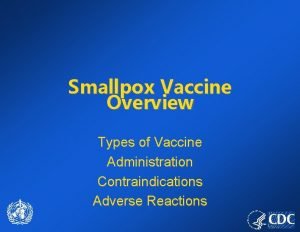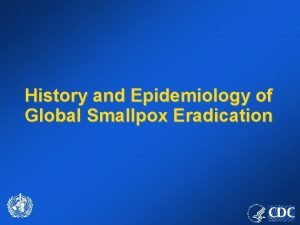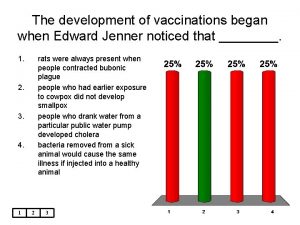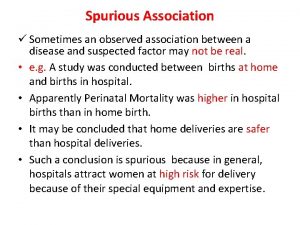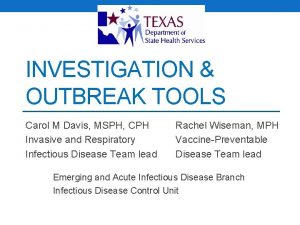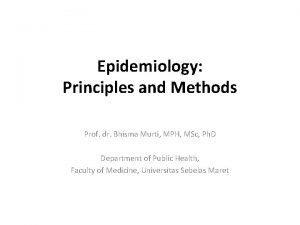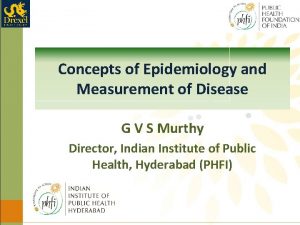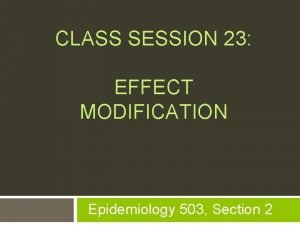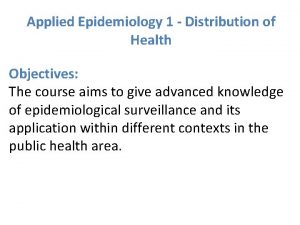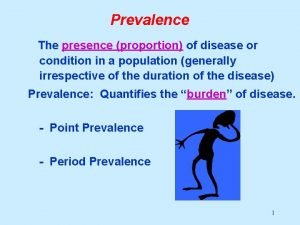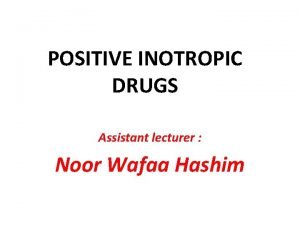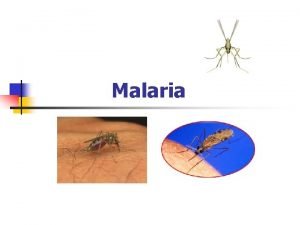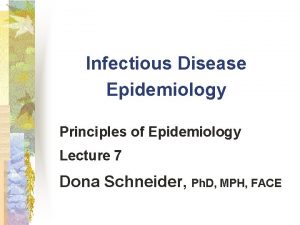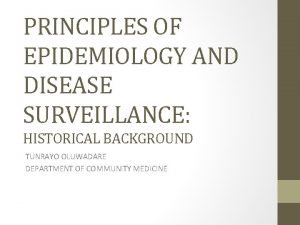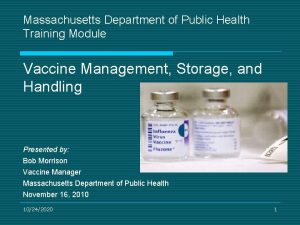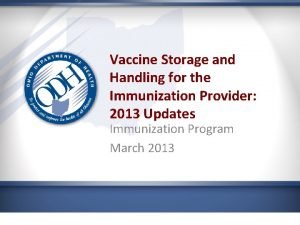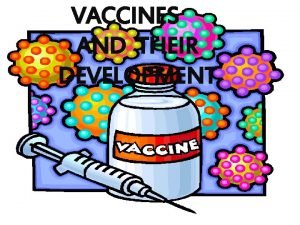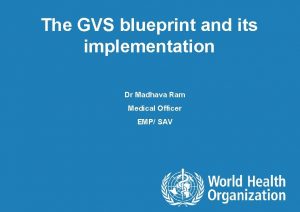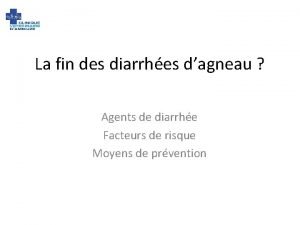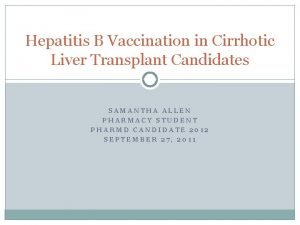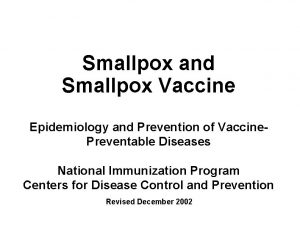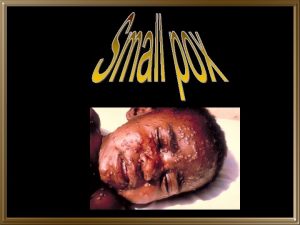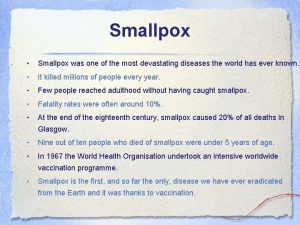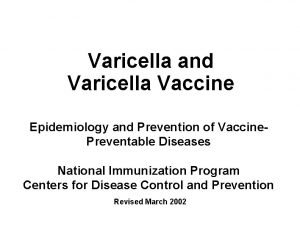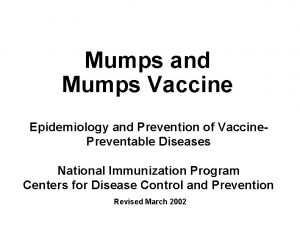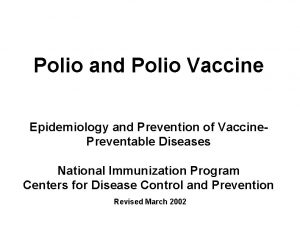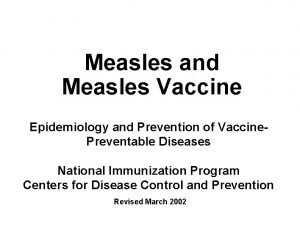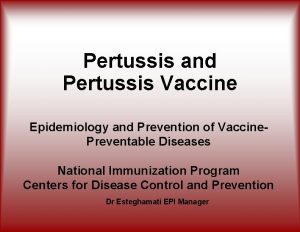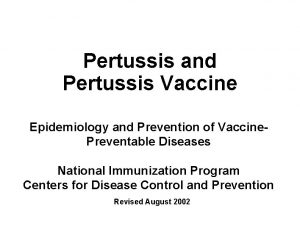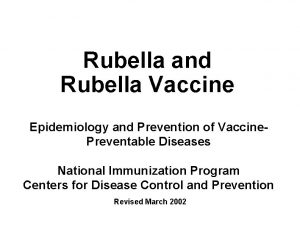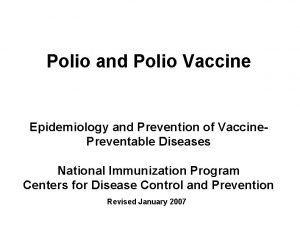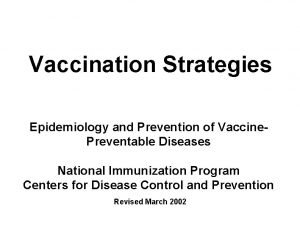Smallpox and Smallpox Vaccine Epidemiology and Prevention of




























































- Slides: 60

Smallpox and Smallpox Vaccine Epidemiology and Prevention of Vaccine. Preventable Diseases National Immunization Program Centers for Disease Control and Prevention Revised January 2006

Note: additional smallpox-related material, including images, slide sets, rash illness algorithm posters and worksheets, and videotapes are available on the CDC smallpox website at http: //www. emergency. cdc. gov/agent/ smallpox/

Smallpox • First described in Chinese text in 4 th century • Vaccine developed in late 18 th century • Last case in U. S. in 1949 • Last indigenous case on earth in 1977

Variola Virus • Orthopoxvirus • Infects only humans in nature • May remain viable in crusts for years at room temperature • Rapidly inactivated by UV light, chemical disinfectants

Smallpox Pathogenesis • Virus contact with oropharyngeal or respiratory mucosa • Virus replication in regional lymph nodes • Viremia on about 8 th day of infection • Virus replication in oral and pharyngeal mucosa and skin

Smallpox Clinical Presentations • Variola major – severe illness – case-fatality rate of >30% • Variola minor – less severe – case-fatality rate of <1%

Clinical Presentations of Variola Major • Ordinary (>90% of cases in unvaccinated persons) • Modified (mild; occurs in previously vaccinated persons) • Flat (uncommon; usually fatal) • Hemorrhagic (uncommon; usually fatal)

Smallpox Prodrome • Incubation period 12 days (range 7 -17 days) • Prodrome –abrupt onset of fever >101°F –malaise, headache, muscle pain, nausea, vomiting, backache –lasts 2 -4 days –not infectious until lesions develop in mouth

Smallpox Rash • Enanthem (mucous membrane lesions) appears approx. 24 hours before skin rash • Minute red spots on the tongue and oral/pharyngeal mucosa • Lesions enlarge and ulcerate quickly • Virus titers in saliva highest during first week of illness

Smallpox Rash • Exanthem (skin rash) appears 2 -4 days after onset of fever • First appears as macules, usually on the face • Lesions appear on proximal extremities, spread to distal extremities and trunk

Smallpox Rash Evolution Stage Macules Papules Vesicles Pustules Crusts All crusts separated Days after Rash Onset 0 -1 2 -3 3 -5 6 -12 13 -20 21 -28

Smallpox Rash • Vesicles often have a central depression (“umbilication”) • Pustules raised, round, firm to the touch, deeply embedded in the skin • Lesions in any one part of the body are in same stage of development • Most dense on face and distal extremities (centrifugal distribution) • Lesions on palms and soles (>50% of cases)

Modified Smallpox • Occurs in previously vaccinated persons • Prodrome may be less severe • No fever during evolution of rash • Skin lesions evolve more quickly • Rarely fatal • More easily confused with chickenpox

Flat Smallpox • Severe prodrome • Fever remains elevated throughout course of illness • Extensive enanthem • Skin lesions soft and flat, contain little fluid • Most cases fatal

Hemorrhagic Smallpox • Prolonged severe prodrome • Fever remains elevated throughout course of illness • Early or late hemorrhagic signs • Bleeding into skin, mucous membranes, GI tract • Usually fatal

Smallpox Complications • Bacterial infection of skin lesions • Arthritis • Respiratory • Encephalitis • Death – 30% overall for ordinary smallpox – 40%-50% for children <1 year –>90% for flat and hemorrhagic smallpox

Differential Diagnosis The most important differentiating feature between smallpox and other rash illnesses is the presence of fever before rash onset

Differential Diagnosis Smallpox • • Severe, febrile prodrome 1 -4 days before rash >101 o. F Other symptoms: – prostration – headache – backache – chills – abdominal pain – vomiting Varicella • • • Mild or no prodrome Little or no fever No associated symptoms

Differential Diagnosis Smallpox • Deep, hard lesions • Round, well circumscribed Varicella • • • Superficial lesions • Lesions at all stages of development • Confluent or umbilicated • Lesions at same stage of development Not well circumscribed Confluence and umbilication not common

Common Conditions With Vesicular or Pustular Rashes • • • Varicella (primary infection with VZV) Disseminated herpes zoster Impetigo Drug eruptions and contact dermatitis Erythema multiforme minor Erythema multiforme incl. Stevens Johnson syndrome Enteroviruses incl. Hand, Foot and Mouth disease Disseminated herpes simplex Scabies and insect bites Molluscum contagiosum

Smallpox Major Criteria • Febrile prodrome 1 -4 days before rash onset; fever of >101°F, and at least 1 additional symptom* • Rash lesions are deep, firm/hard, round and well circumscribed • On any one part of the body lesions in same stage of development *Prostration, headache, backache, chills, vomiting or severe abdominal pain

Smallpox Minor Criteria • Greatest concentration of lesions on face and distal extremities • Lesions first appear on oral mucosa/palate, face, or forearms • Patient appears toxic or moribund • Lesions evolve from macules to papules to pustules • Lesions on palms and soles

Risk of Smallpox by Clinical History and Examination • High risk – febrile prodrome – classic smallpox lesions – same stage of development • Moderate risk – febrile prodrome – 1 major OR >4 minor criteria • Low risk –no febrile prodrome –febrile prodrome and <4 minor criteria

Laboratory Confirmation • Rapid diagnostic testing for varicella zoster virus (DFA, IFA, PCR) • Electron microscopy (may identify Orthopoxvirus but not specific for variola) • Culture • Nucleic acid-based testing • Serologic testing

Smallpox Medical Management • Notify public health authorities immediately for suspected case • Strict respiratory and contact isolation • Supportive care • Antiviral agents?

Smallpox Epidemiology • Reservoir Human (before eradication) • Transmission Respiratory by large particles Can be airborne • Communicability From onset of rash until all crusts separate

Smallpox Epidemiology • Most transmission results from face-to-face contact with infected person (household and hospital contacts) • Transmission most frequent during first week of rash

Smallpox Eradication • Intensified Global Eradication program begun in 1966 • Initial strategy was mass vaccination • Strategy evolved to “surveillance and containment” • Last indigenous case in Somalia in October 1977

Smallpox Vaccine 1796 Edward Jenner develops vaccine 1805 Use of cows to produce vaccine 1940 s Freeze-drying technology 1965 Licensure of bifurcated needle 1972 Routine vaccination stopped in U. S. 1983 Vaccine removed from civilian market

Smallpox Vaccine • Live vaccinia virus in calf lymph • Contains trace amounts of polymyxin B, streptomycin, tetracycline, and neomycin • Diluent contains glycerin and phenol • New vaccine produced using cell culture technology does not contain antibiotics

Response to Smallpox Vaccination • Neutralizing antibody develops – 10 days after primary vaccination – 7 days after revaccination • >95% of primary vaccinees develop detectable neutralizing antibody • Antibody persists >10 years

Smallpox Vaccine Efficacy • Clinical efficacy estimated in household contact studies • 91%-97% reduction in cases among contacts with vaccination scar • Studies did not consider time since vaccination or potency of vaccine

Duration of Immunity Following Smallpox Vaccination • High level of protection (~100%) for up to 5 years following vaccination • Substantial but waning immunity for >10 years • Reduction in disease severity among previously vaccinated persons

Smallpox Fatality Rate by Time Since Vaccination—Europe, 1950 -1971* *Mack TM. J Infect Dis 1972; 125: 161 -9.

Postexposure Vaccine Efficacy • Secondary attack rates reduced up to 91% compared to unvaccinated contacts • Lowest disease rates among persons vaccinated <7 days after exposure • Disease generally less severe (modified-type) in persons receiving postexposure vaccination

Post Exposure Vaccine Efficacy Madras % with smallpox 29. 5 Postexp vacc 47. 6 Never vacc Pakistan Vacc <10 days Never vacc 75. 0 96. 3 Pakistan Vacc <7 days Never vacc 1. 9 21. 8

Clinical Response to Smallpox Vaccination* Symptom/Sign Time after vac Papule 3 -4 days Vesicle 5 -6 days Pustule 7 -11 days Maximum erythema 8 -12 days Scab 14 days Scab separation 21 days *typical response in a nonimmune person

Clinical Response to Smallpox Vaccination • Major (primary) reaction –indicates viral replication has occurred and vaccination was successful –considered to be protected with the development of a major reaction • Equivocal reaction –indicates immune suppression of viral replication, allergic reaction without production of immunity, incorrect vaccination technique, or impotent vaccine –revaccinate immediately

Evolution of U. S. Smallpox Vaccine Recommendations • 1972 • 1976 • 1980 Discontinue routine vaccination • 1990 • 1991 Discontinue vaccination of military • 2001 • 2002 Bioterrorism guidelines Discontinue vaccination of HCWs Vaccine recommended for lab workers Consider vaccine for HCWs exposed to recombinant vaccinia Smallpox Response Teams

Smallpox Vaccine Indications in Nonemergency Situations • Laboratory workers who handle cultures • • or animals infected with non-highly attenuated vaccinia Laboratory workers exposed to other Orthopoxviruses that infect humans Consider for other healthcare workers with contact with contaminated material Public health, hospital, and other personnel who may need to respond to a smallpox case or outbreak Persons who vaccinate others

Smallpox Vaccine Indications in Emergency Situations* • • Persons exposed to initial release • Direct care or transportation of confirmed or suspected case-patient • • Laboratory personnel • Other groups as recommended by public health authorities Close contact with confirmed or suspected case Persons with risk of contact with infectious materials from patient *following confirmation of a case of smallpox

Smallpox Vaccine • Schedule – 1 successful dose • Revaccination – 10 years (non-highly attenuated vaccinia and recombinants) – 3 years (more virulent Orthopoxviruses)

Smallpox Vaccine Local Reactions Among Susceptible Adults • Pain, swelling, erythema at vaccination site • Regional lymphadenopathy –begins 3 -10 days after vaccination –can persist for 2 -4 weeks after vaccination site heals

Smallpox Vaccine Reactions Among Susceptible Adults • Elevated temperature – 5%– 9% – 3% >100°F >102°F • Systemic symptoms (malaise, myalgia) • 36% sufficiently ill to miss work, school, or recreational activities or had trouble sleeping

Smallpox Vaccine Adverse Reaction Rates* Reaction Inadvertent inoculation Primary Vaccination 25 -529 Generalized vaccinia 23 -242 Eczema vaccinatum 10 -39 Progressive vaccinia 0. 9 -1. 5 Postvaccinial encephalitis Death *Rates per million primary vaccinations 3 -12 1

Inadvertent Inoculation • Caused by transfer of vaccinia virus from site of vaccination to other areas of the body • Most commonly on face, eyelid, nose, mouth, rectum, genitalia • Most lesions heal spontaneously without specific treatment

Generalized Vaccinia • Results from viremia with implantations in the skin • Occurs in the absence of eczema or other preexisting skin diseases • Vesicles or pustules on normal skin distant from vaccination site • Usually minor illness with little residual damage

Eczema Vaccinatum • Generalized spread of vaccinia on skin of patients with eczema or atopic dermatitis, or past history of eczema or atopic dermatitis • Occurs in vaccinees and contacts • Can occur whether eczema is active or quiescent • May be severe or fatal

Progressive Vaccinia • Progressive necrosis at site of vaccination, often with metastatic lesions • Occurs in patients with impaired immunologic function, particularly cellular immunodeficiency • Frequently fatal

Postvaccinal Encephalitis • Highest risk among children <12 months of age and older persons receiving primary vaccination • Believed to result from autoimmune or allergic reaction • Frequently fatal or neurologic sequelae

Fetal Vaccinia • <50 fetal vaccinia cases reported in world literature • Most result from primary vaccination of mother early in pregnancy • Usually results in stillbirth or death of infant soon after delivery • Congenital malformations not reported

Smallpox Vaccine Contraindications and Precautions (Nonemergency Situations) • • • Severe allergic reaction to a vaccine component or following a prior dose Immunosuppression in the recipient or household contact Physician-diagnosed heart disease or risk factors for heart disease Pregnancy in the recipient or household contact Breastfeeding

Smallpox Vaccine Contraindications and Precautions (Nonemergency Situations) • Eczema or atopic dermatitis (current or past history) in the recipient or household contact • Acute, chronic, or exfoliative skin conditions (until improved or resolved) in the recipient or household contact • Children <12 months of age • Moderate or severe acute illness

Smallpox Vaccine Contraindications and Precautions Emergency (Postrelease) Situations • Exposed persons—no contraindications • Unexposed persons—same as nonemergency situations

Vaccinia Immune Globulin Intravenous • Immunoglobulin fraction of plasma from persons vaccinated with vaccinia vaccine • Effective for treatment of eczema vaccinatum, progressive vaccinia, severe generalized vaccinia, and ocular vaccinia • Not effective in postvaccinial encephalitis

Vaccine Storage and Handling • Stable indefinitely at -4°F (-20°C) • Store unreconstituted vaccine at 35 -46°F (2°-8°C) • Reconstituted vaccine must be used within 90 days • Avoid contamination after opening vial

Smallpox Response Plan • Key elements: –surveillance and investigation of cases –contact tracing –isolation guidelines –specimen collection and handling –communications –decontamination

Smallpox Response Teams • Emergency, healthcare workers and other critical personnel may be asked to volunteer to receive the vaccine • Department of Defense will also vaccinate certain personnel who are or may be deployed in high threat areas • Some personnel assigned to certain overseas embassies may be offered vaccination • Does not include a recommendation for vaccination of the general public

Bioterrorism Information CDC Emergency Preparedness and Response Website www. emergency. cdc. gov

National Immunization Program Contact Information • Telephone 800. CDC. INFO • Email nipinfo@cdc. gov • Website www. cdc. gov/vaccines
 Primary prevention secondary prevention tertiary prevention
Primary prevention secondary prevention tertiary prevention Smallpox vaccine inventor industrial revolution
Smallpox vaccine inventor industrial revolution Eczema vaccine contraindication
Eczema vaccine contraindication Monkeypox
Monkeypox Smallpox
Smallpox Smallpox disfigurement
Smallpox disfigurement Why was the cherokees last treaty a sham
Why was the cherokees last treaty a sham Smallpox endemic
Smallpox endemic Smallpox definition ap world history
Smallpox definition ap world history A vaccination for smallpox was developed in 1796 by ____
A vaccination for smallpox was developed in 1796 by ____ Difference between descriptive and analytic epidemiology
Difference between descriptive and analytic epidemiology Nutrition epidemiology definition
Nutrition epidemiology definition Difference between descriptive and analytical epidemiology
Difference between descriptive and analytical epidemiology Difference between descriptive and analytical epidemiology
Difference between descriptive and analytical epidemiology Certification board of infection control and epidemiology
Certification board of infection control and epidemiology Descriptive epidemiology
Descriptive epidemiology Ukuran asosiasi statistika
Ukuran asosiasi statistika Logistic regression epidemiology
Logistic regression epidemiology Incidence density formula
Incidence density formula Classification of epidemiological studies
Classification of epidemiological studies Attack rate formula
Attack rate formula Pros and cons of cross sectional study
Pros and cons of cross sectional study Association and causation
Association and causation Formula for attack rate
Formula for attack rate Ramboman acronym
Ramboman acronym Epidemiological wheel
Epidemiological wheel Defination of prevalence
Defination of prevalence Defination of epidemiology
Defination of epidemiology Distribution in epidemiology
Distribution in epidemiology What is descriptive study in epidemiology
What is descriptive study in epidemiology Spurious association in epidemiology
Spurious association in epidemiology Field epidemiology ppt
Field epidemiology ppt Bhisma murti
Bhisma murti Gordon epidemiology
Gordon epidemiology Epidemiology kept simple
Epidemiology kept simple Diabetic ketoacidosis epidemiology
Diabetic ketoacidosis epidemiology Distribution in epidemiology
Distribution in epidemiology Confounding vs effect modification
Confounding vs effect modification Distribution in epidemiology
Distribution in epidemiology Ramboman
Ramboman Epidemiology definition
Epidemiology definition Period prevalence formula
Period prevalence formula How dr. wafaa elsadr epidemiology professor
How dr. wafaa elsadr epidemiology professor Epi
Epi Mp test for malaria
Mp test for malaria Secondary attack rate formula
Secondary attack rate formula How dr. wafaa elsadr epidemiology professor
How dr. wafaa elsadr epidemiology professor Epidemiology definition
Epidemiology definition Define epidemiology
Define epidemiology Epidemiology triad
Epidemiology triad Celiac beri beri
Celiac beri beri Orlies
Orlies Vaccine storage and handling sop worksheet
Vaccine storage and handling sop worksheet Vaccine storage and handling protocol
Vaccine storage and handling protocol What is the definition of a vaccine
What is the definition of a vaccine Edible vaccine definition
Edible vaccine definition Global vaccine safety blueprint
Global vaccine safety blueprint Postexposure prophylaxis for rabies
Postexposure prophylaxis for rabies Imocolibov vaccin
Imocolibov vaccin Hepatitis b vaccine series adults
Hepatitis b vaccine series adults How to mix shingrix vaccine
How to mix shingrix vaccine


